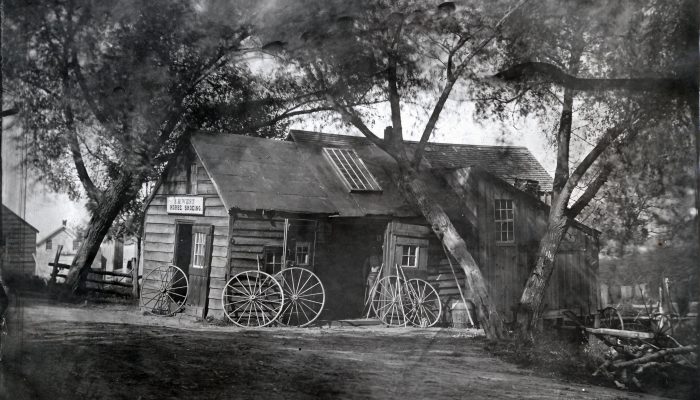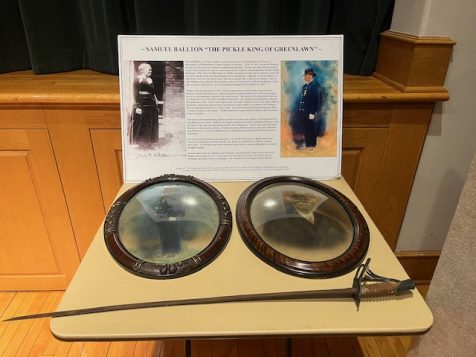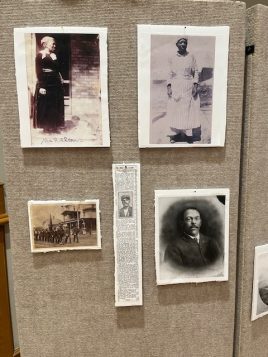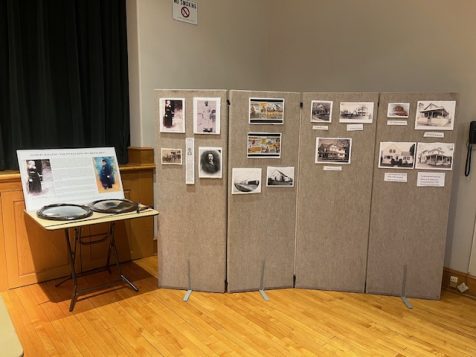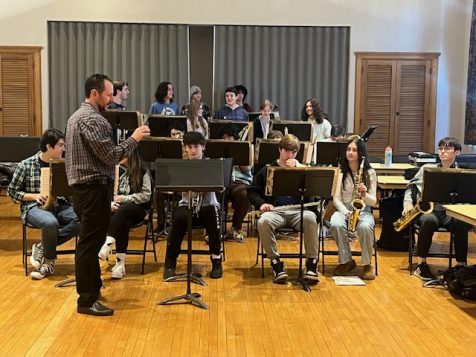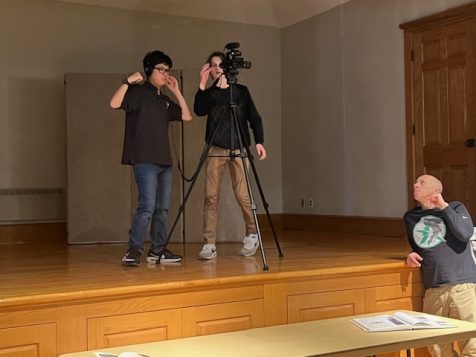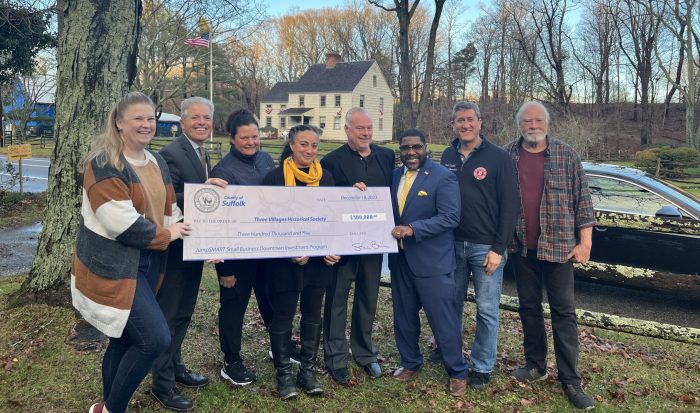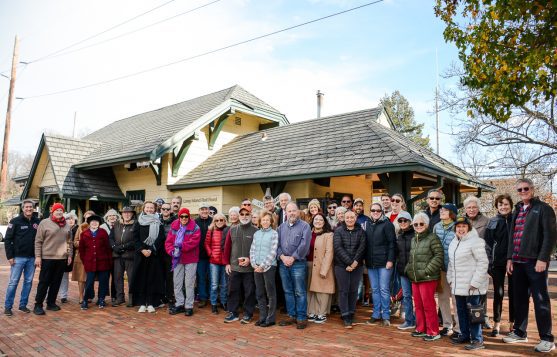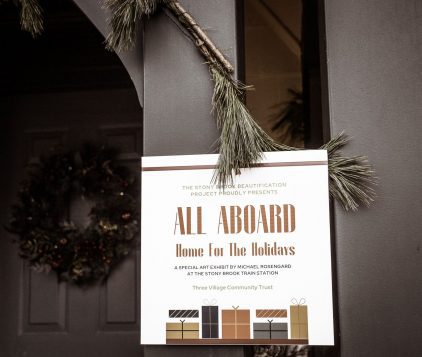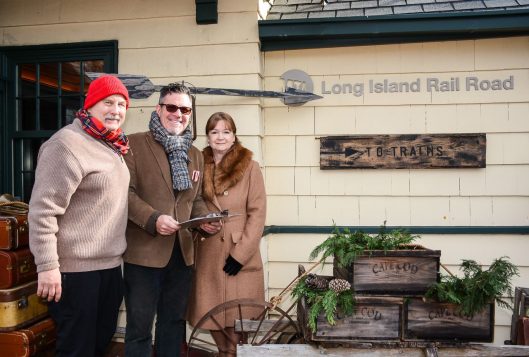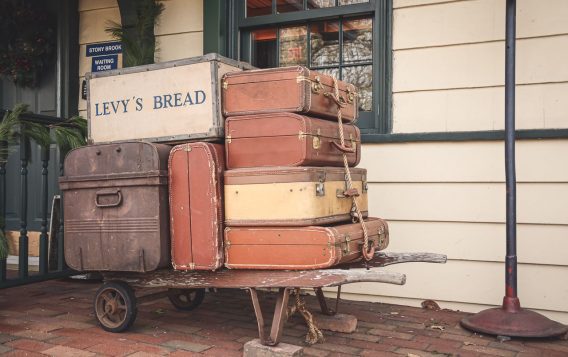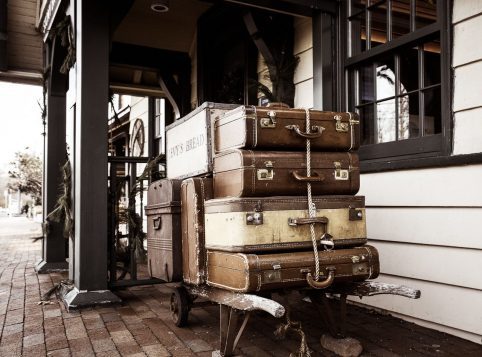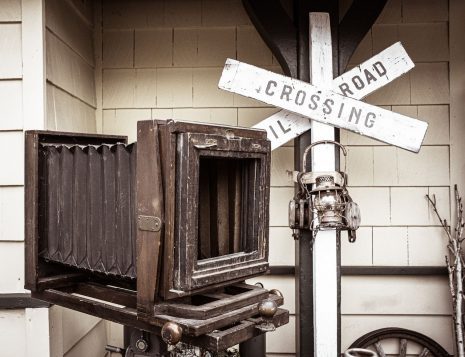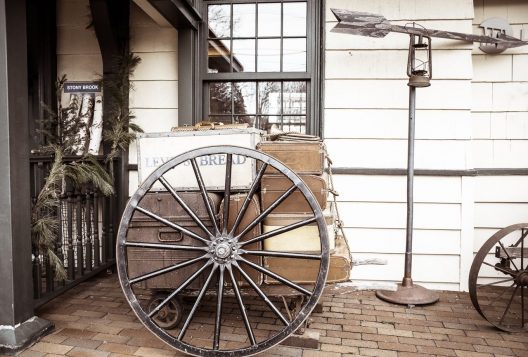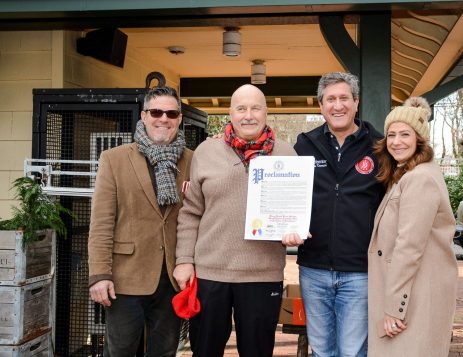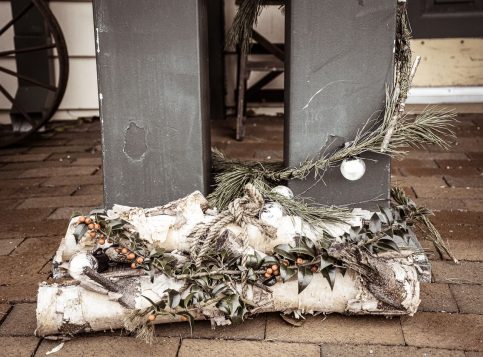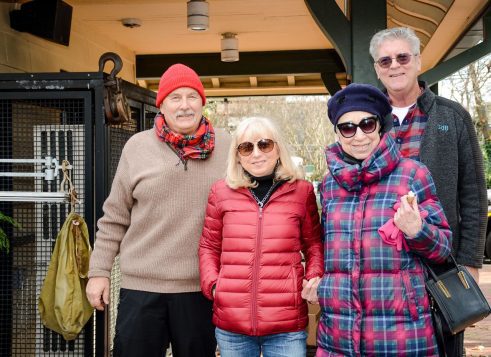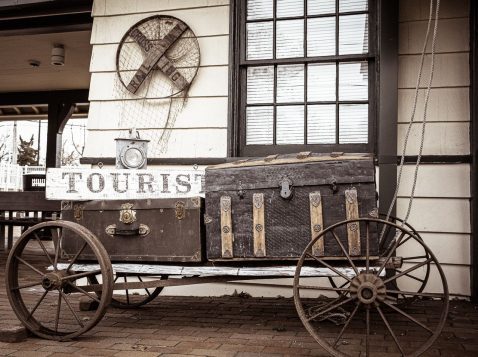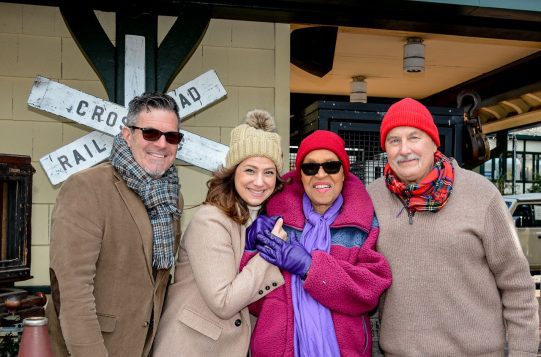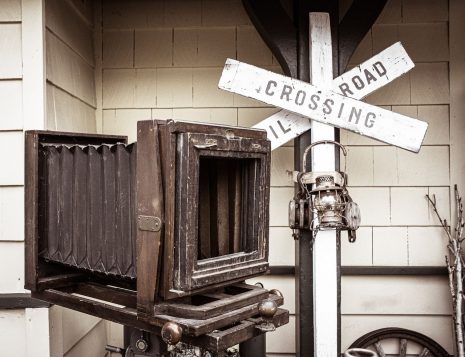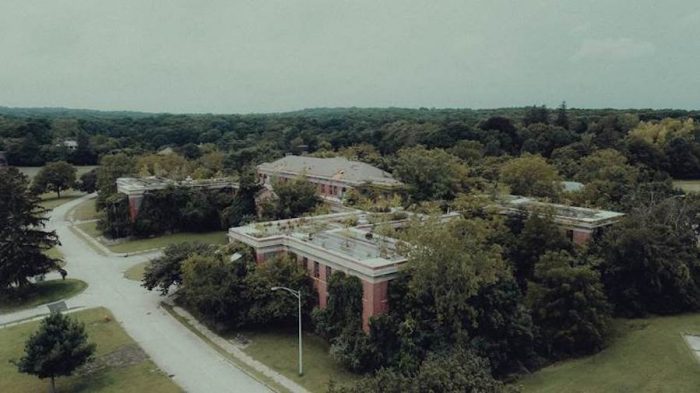Join the Northport Historical Society, 215 Main St., Northport for a Victorian Valentine’s Day on Thursday, Feb. 8 at 7 p.m. Make your date night, Gal-entine’s, or early Valentine’s Day celebration unforgettable! Education Coordinator Carol Taylor takes you on a journey from the beginning of Valentine’s Day to modern times while learning (and sampling) wine paired with handcrafted chocolates. Your evening concludes with a gift provided by Nite Owl Promotions. Tickets are $60, $50 members and must be purchased in advance at www.northporthistorical.org. Ages 21+ only. Questions? Call 631-757-9859.
The intersection of sports and the Great Depression
“It’s not a question of whether you will hurt, or of how much you will hurt; it’s a question of what you will do, and how well you will do it, while pain has her wanton way with you.” ― Daniel James Brown, The Boys in the Boat: Nine Americans and Their Epic Quest for Gold at the 1936 Berlin Olympics
Gazing over the tens of thousands of foreigners entering the arena that would be the 1936 Berlin Olympic games stood the presence of dictator Adolf Hitler. During the midst of the Great Depression, the tyrannical leader of Nazi Germany promised to rebuild his nation to its former glory.
In 1931, the International Olympic Committee permitted the summer games to be held in Berlin as a peaceful way of putting World War I behind the Europeans. Instead, the world saw the flying of Swastikas signaling the rise of Nazi Germany. The games began on Aug. 1, 1936, with Hitler present to watch his country prove its status as a restored national power.
A rumored American boycott to oppose the fierce Nazi treatment of its minorities, loomed over, though President Franklin D. Roosevelt granted his country’s athletes to participate in these games.
Watching the ignition of the Olympic flame, stood Jesse Owens or “Buckeye Bullet”. Owens a famed-athlete, grew up in an Alabama sharecropping family, where much of his childhood was riddled with racism. Despite his adversarial childhood, Owens went on to become a talented track and field athlete at Ohio State University. It soon became a goal of Owen’s to dispel the Nazi “Aryan” propaganda promoting others inability to defeat Hitler’s “Master Race” of athletes.
Hitler’s much-publicized hatred did not shake the American resolve of Owens and the other African American participants. American runners went on to earn 11 gold medals in track and field; six by Black athletes, with Owens earning four gold medals and two impressive Olympic records.
Later in the games, a fatigued Owens sought rest, with this, he offered the torch to American teammates, Marty Glickman and Sam Stoller suggesting they could compete in 4×100 race in his stead. Instead, Owens was directed to race and Glickman and Stoller, both of Jewish culture, were barred from participating. Concerns arose that American coaches were fearful of upstaging Hitler by using Jewish-American athletes to gain additional medals.
An aspect of these games often overlooked is the athlete’s personal contention with the economic and social issues of the Great Depression. The economy was poor in Germany and its regime paid for the training and living expenses of its athletes. Many American athletes looked at sports in a secondary manner as they tried to gain essential items to survive. Americans had to contend with twenty-five percent unemployment and a struggling economy.
On Christmas Day, Hollywood released a heartwarming look at the tribulations of the Great Depression through the production of ‘The Boys in the Boat’, written by Brown and directed by George Clooney. Like ‘Cinderella Man’ and ‘Seabiscuit’, this film delves into the intersection of sports and the Depression.
Even as the New Deal was established by Roosevelt, American people faced difficulties in finding work and buying food. ‘The Boys in the Boat’ is based on the Washington State Rowing Team’s quest to win the gold medal during the Berlin Olympics.
This film, set on the outskirts of Seattle, chronicles the harsh extent of the Depression. It focused on Joe Rantz, who was abandoned by his family and forced to care for himself. Actor Callum Turner portrayed an engineering student facing the threat of removal from Washington State for being unable to pay his tuition. With holes in his shoes and making a home in an abandoned car, this student desperately sought a chance to improve his economic situation by trying out for his school’s rowing team.
Joel Edgerton stars as Coach Al Ulbrickson, an uncompromising figure who demanded athletic and physical excellence. The film takes some artistic liberties depicting the triumphs of the team modifying the succession to highest levels of college and Olympic competition to one year as opposed to the three years presented in Brown’s book.
As a director Clooney scores in the eyes of film, history, and sports fans. He portrays the determination of the team’s coach in utilizing a junior varsity team that would eventually become the best in the nation and would go on to win a gold medal.
There are many moments that present Rantz’s competitive side. In the film, Rantz found a father figure in the team’s boat builder, a man who took a special interest in his athletic talents by constructing and maintaining their equipment. The builder provided sustinent advice on handling the complexities of life and listening to authority. This film identifies the American-will to persevere, showcasing a team pitted against highly-respected Ivy League crews. The film shares an outstanding story of American resilience to achieve greatness through the masterful stroke of Clooney’s direction.
History Close at Hand: Samuel West, Setauket blacksmith
By Beverly C. Tyler
The first of the West family line to come to the Three Village area were Mary Morris West and her two sons Kendall (known as Harvey) and Ebenezer. In 1836 Mary’s husband, Ebenezer West, died in Delaware. The 1850 census lists a Mary M. West, of the right age and birthplace, living in Connecticut with another family, suggesting she may have moved there from Delaware. By 1860, the West family bought a house on Old Town Road. Mary and Harvey were living there along with his wife, Mary Eliza Terrell, whose family lived just south at Walnut Tree Farm, and three children, including Samuel.
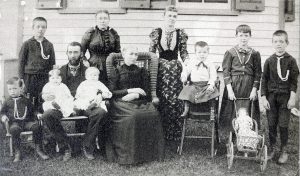
Carrie West, wife of Clinton West, noted that her father-in-law Samuel, born on April 8, 1953 in East Setauket, went to Bay Shore to learn the blacksmithing trade of George Thorne. Here, Samuel boarded with the Thornes and spoke of them as a fine family. In 1875, he bought the old Elbert Wheeler blacksmith shop that had earlier belonged to blacksmith William Smith, who owned the house on the corner of Main St. and Gnarled Hollow Road.
As told by Clinton’s son, Forrest West, “In April of 1881, West had a new shop built on the same site as his first and eventually added a two-story building next door where carriages were repaired.”
Carrie West noted, “Houses were built up to West’s blacksmith shop. Samuel West was a thorough high-class mechanic, a hard worker, a man of integrity, a devout Christian, a worker for temperance, devoted to his family and home. He had an extensive horse-shoeing trade where he shod the numerous running horses for the Vinguts, farm horses and many carriage horses for Strongs, Tinkers, Rebouls and many other well-known families from Miller Place to Smithtown. He was a clever ironworker; he did the carriage and wagon repair work for the community. He was a wagon maker and built farm wagons, light delivery wagons, and butcher wagons and sleds. He enjoyed hunting and he and Mr. Selah B Strong with their bird dogs enjoyed hunting together. They were great friends. Special horses were brought from a distance, because of his ability in handling them. His shop was a well-equipped, light shop, always very neat, and it has been said by his customers he was always so gentlemanly and courteous.”
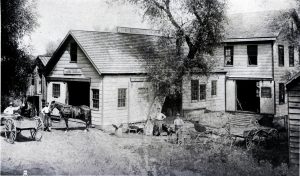
In 1879, Samuel married Ida Augusta Hulse. Together they kept house in a rented home on Station Road, now named Gnarled Hollow Road. Here, five of their children were born. In 1889, he built a spacious two-story house on the corner of Main St. (now 25A) and Bayview Ave, where five more children were born, the first being twins. A great tragedy came to this happy family when Ida Augusta died in 1899 at the birth of the tenth child.
Samuel’s only sister, Mary Emmaline Loper (Mrs Gilbert E. Loper Sr.) of Port Jefferson, took his tenth baby into her home and tenderly brought her up with their children. Although crushed in heart, Samuel, a faithful father, brought his large family up in a splendid useful manner, each helping the other. He lived to enjoy four generations. (Based on Carrie West’s notes).
West used the 1881 shop until the 1930s, practicing as one of two East Setauket blacksmiths (Henry Rakow, the other smith, operated a shop on Shore Road.) West’s shop moved in 1951 to become a part of what is now the Long Island Museum of American Art, History and Carriages in Stony Brook. The shop still can be seen with most of the equipment used by West to make and repair the metal parts of wagon wheels, shoe horses, and fashion various items that were essential to the community.
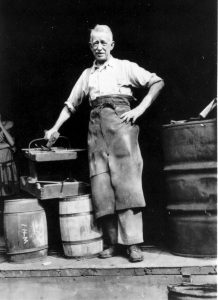
As detailed in the “Island News” on August 15, 1932, “Three years and six months before entering the blacksmith trade, Mr. West went to sea with his father, who was by trade a spar maker. This October will end the 57th year he has been open for business on the same spot…One man in Miller Place calls in his car to take the smithy to his horse. He now charges $3 a head but [the Miller Place man] pays three and a half times as much for shoes. Mr. West says that when he first raised his price one customer sold his horses rather than pay it.”
It is difficult now to understand how important the blacksmith was to this community from the first settlement through the early twentieth century. The blacksmith was vital to the early farm family as he was an artisan, performing a trade in which few men had the ability to do themselves. Working mostly with iron, he produced hand-cut nails; farm tools, such as axes and hoes; cooking utensils, such as pot hooks, toasters and dippers; and hardware for houses and barns, including hinges and door bolts. He was also a farrier, shoeing horses and oxen. The blacksmith took a great deal of pride in his work as evidenced by the fine ornamental iron pieces that exist as candle holders, gates and other decorative accents. Many blacksmiths also provided various related or unrelated services for the community, such as pulling teeth for local residents and treating horses for minor ailments. These services were quickly abandoned when a doctor or a veterinarian was available
Beverly Tyler is Three Village Historical Society historian and author of books available from the Three Village Historical Society, 93 North Country Rd., Setauket, NY 11733. Tel: 631-751-3730. http://WWW.TVHS.org
Photo of the Week
A BEACON OF LIGHT
John Dielman of East Setauket recently captured this incredible birds-eye view of the Old Field Point Lighthouse using a drone.
The 154-year-old building overlooking the Long Island Sound is one of 36 properties in New York and the only one on Long island to be nominated to the State and National Registers of Historic Places in 2023. Governor Kathy Hochul made the announcement on Dec 29.
“Identifying these resources and adding them to our historic registers expands our ongoing understanding of our shared history and are important reminders of the innovation, passion, and lived experiences of New Yorkers who came before us,” said Hochul.
Originally fueled by oil, the 50-foot tall light station is now unmanned and relies on electricity, but remains an active lighthouse and also serves as the Old Field Village Hall on the first floor.
Send your Photo of the Week to [email protected]
Harborfields High School Jazz Band forges community connections with The Greenlawn Centerport Historical Association
On Tuesday, December 12, 2023, the Greenlawn Centerport Historical Association hosted the Harborfields High School Jazz Band for a focus session on local hero Samuel Ballton.
Born into slavery in Westmoreland, Virginia in 1838, Ballton found his way to freedom three times, finally escaping the South for good with his wife, Rebecca. Arriving in Greenlawn in 1873, Ballton found employment with Alexander Gardiner and was eventually dubbed Greenlawn’s “Pickle King” when he grew and processed more than 1.5 million pickles in a single season.
Harborfields High School Jazz Band Leader Dan Bilawsky, having developed an interest in Ballton’s life, commissioned an original jazz composition about his story and, to learn more about “The Pickle King,” attended a Walking Tour and Pub Crawl in June of 2023. Through discussions with Town of Huntington Historian Robert Hughes at that event came the idea of creating deeper community connections by bringing the jazz band to the GCHA to learn more about local history and, specifically, Ballton.
During the field trip, Hughes spoke to the band and the GCHA created a temporary exhibit complete with photos, memorabilia, and Samuel Ballton’s sword. This visit also served as a part of a larger project for the students—a documentary on “The Pickle King” to be co-produced by the high school’s media journalism students and the jazz band.
“Our plan is to premiere this musical selection at our December concert to tie into the sesquicentennial of Ballton’s arrival in Greenlawn, and then put together a short documentary about ‘The Pickle King’—man and music,” Dan Bilawsky shared.
Hughes and Executive Director Claudia Fortunato-Napolitano were interviewed by the students for this forthcoming production. “The students did a great job, and they were fascinated to hear about Samuel Ballton and his journey in life, from being born a slave to becoming a pioneering figure in Greenlawn,” remarked Fortunato-Napolitano. “At the conclusion of their visit, the band presented our organization with a copy of the score signed by the composer, Jeff Lederer, which is now in the GCHA archives. The jazz band also performed the piece, and it was wonderful!”
The Greenlawn Centerport Historical Association is a non-profit membership organization with a mission to research, collect, record, and preserve artifacts, photographs, fine arts, and ephemera of Greenlawn & Centerport. In addition, they promote the preservation of historic structures and maintain two historic homesteads to provide the public with an opportunity to learn about early life on Long Island.
Three Village Historical Society awarded JumpSMART grant
By Samantha Rutt
The Three Village Historical Society was awarded a $300,000 grant, courtesy of the JumpSMART Small Business Downtown Investment Program on Monday afternoon, Dec. 18.
Suffolk County Executive Steve Bellone (D) and other local officials gathered at Gallery North to present the organization with a giant check signifying the donation.
Along with the Three Village Historical Society, the Ward Melville Heritage Organization, LI Music and Entertainment Hall of Fame and Gallery North – Setauket Historic District also received generous grants from the JumpSMART program. The donations’ funding will be used to support downtown revitalization efforts.
“The funding that we’re distributing here is about supporting our downtowns and our cultural institutions that are so important,” Bellone said. “Much of the funding comes out of the award that we received from the federal government — they really are about promoting economic sustainability over the long term, and I can’t think of a better way to do that than investing in our cultural arts and institutions like the ones here.”
Book Review: ‘From Angels to Werewolves — Animal-Human Hybrids in Myth and Art’
By Elizabeth Kahn Kaplan
St. James resident Philip F. Palmedo has produced a beautifully written and generously illustrated book on a subject that has intrigued, delighted, and frightened children and adults from ancient days to the present: therianthropy, the mythological ability of humans to metamorphose into animals or animal-human hybrids.
“The concept of the therianthrope can catalyze the creative imagination,” writes Palmedo.
The first that we know of is the Upper Paleolithic Lion-Man carved out of woolly mammoth ivory some 40,000 years ago. While we can only conjecture why it was created, we know that more recent animal-headed deities like the jackal-headed Egyptian god Anubis played important roles some 5000 years ago in weighing the worth of a person after death.
In the Hindu pantheon, elephant-headed, four-armed Ganesha is widely revered as a bringer of good luck; in Christian art winged angels abound, by turns avenging and comforting. In the 20th century, the ancient Greek legend of the fearsome Minotaur, a man with the head and tail of a bull, served as Pablo Picasso’s “allegorical alter-ego . . . with many of his etchings, paintings, and sculptures featuring this mythical bull-man.”
 Imaginative minds past and present have created talking animals, from the wicked snake in Genesis that tempted Eve in the Garden to the Cowardly Lion in The Wizard of Oz, Disney’s Mickey Mouse and Donald Duck, and lovable Big Bird of Sesame Street.
Imaginative minds past and present have created talking animals, from the wicked snake in Genesis that tempted Eve in the Garden to the Cowardly Lion in The Wizard of Oz, Disney’s Mickey Mouse and Donald Duck, and lovable Big Bird of Sesame Street.
Shape-shifting, the ability to change from human to animal or to an inanimate object, abounds in Greek mythology. One rather improbable example is that of the god Zeus changing into a swan to seduce Leda. In another example, as retold by the ancient Roman poet Ovid, the beautiful river nymph Daphne was “shapeshifted” by her father, morphing into a laurel tree to defeat the unwelcome advances of Apollo, the Greek god of the arts. The sadder but wiser Apollo paid tribute to her by adopting the laurel wreath as his crown.
In America, therianthropy is on display in The Wolf Man horror films, from Lon Chaney’s 1941 portrayal to Benicio del Toro’s in 2010. More recently, the widely consumed Harry Potter tales spun by prolific British writer J. K. Rowling charmed children and adults with a talking bird, Hedwig, and with Firenze, the centaur who rescued Harry from the villain Voldemort.
Centaurs, mythic creatures with the upper body of a human and the lower body and legs of a horse, are the land complement to creatures with human upper torsos ending in huge fish tails — mermen and the alluring mermaids sighted by lonely mariners whose names derive from the French word for the sea, La mer. Palmedo’s chapter, Merpeople, is richly illustrated with examples in art from 6000 BC Serbia and 4th century BC Greece to 19th and 20th century India, Japan, Great Britain, and Denmark, including the bronze sculpture The Little Mermaid that overlooks the harbor in Copenhagen. Based on Hans Christian Andersen’s tale published in 1837, that fable might bring tears to one’s eyes.
On the other hand, Norman Rockwell’s 1955 Saturday Evening Post cover, The Mermaid, can only make us chuckle with its depiction of an elderly fisherman hauling a beautiful mermaid home, her long elegant tail protruding from the large wooden fish trap on his back.
This elegant, art-illustrated book written with clarity, printed on glossy paper, will entertain and enlighten. It can be purchased from Amazon.
ABOUT THE AUTHOR:
A Ph. D. in Nuclear Engineering from M.I.T., Philip F. Palmedo, former head of the Energy Policy Analysis Division at Brookhaven National Laboratory, was for many years Chairman of the Washington-based International Resources Group, which he founded. A former Trustee of Williams College in Massachusetts, where he majored in Physics and Art History as an undergraduate, Palmedo formed and was President of the Long Island Research Institute. He also serves on the MIT Council for the Arts, and is a fellow of the Williams College Museum of Art. Palmedo’s previous book was Deep Affinities: Art and Science.
‘All Aboard Home — For The Holidays’ art installation opens at the Stony Brook Train Station
The Three Village Community Trust, the Three Village Civic Association, the North Suffolk Garden Club, the Three Village Chamber of Commerce and students and faculty at the Stony Brook School, and the Three Village Historical Society are partners in a Beautification Project at the Stony Brook Train Station. Over the past year, significant progress has been made removing debris, weeds, and invasive plants from the landscaped beds. And a wide variety of Long Island native plants have been added to the landscaped beds.
As part of their ongoing efforts, the Stony Brook Train Station Beautification Committee invited local artist Michael Rosengard to create a unique art installation at the Station titled ‘All Aboard – Home For The Holiday.’ This outdoor work of art, located outside the front entrance of the historic Stony Brook Station House, creates a sense of wonder and whimsy to those walking or driving past the Station, highlights the history and importance of the Long Island Rail Road, celebrates the accomplishments of the Beautification Project, and helps kicks of the Holiday Season.
The community celebrated the opening of the exhibit on Monday, December 4th!
Preservation Long Island announces 2023 list of endangered historic places
Properties in Brentwood, Huntington, Kings Park, North Hempstead, Oyster Bay, Riverhead, and Smithtown are included in Preservation Long Island’s biennial list of Endangered Historic Places.
Preservation Long Island’s 2023 Endangered Historic Places List features seven nominated sites that span Long Island from a lighthouse on the Sound off Kings Point, to an early power plant in Riverhead. From historic homesteads to an expansive former mental health campus, the latest list highlights the historical richness of the region.
The Preservation Long Island (PLI) Endangered Historic Places Program (EHPP) is designed to identify, highlight, and address the imminent threats faced by significant historical sites and structures across Long Island. Properties are nominated to the list by concerned citizens and groups on Long Island. The program aims to raise public awareness about the endangered status of these historical places. PLI engages in advocacy efforts to garner support from the local community and beyond, emphasizing the importance of preserving these sites for future generations.
“The program offers Long Islanders an opportunity to advocate for preservation in their communities while learning how to use tools like landmark designation, tax incentives, and public outreach,” said Alexandra Wolfe, Preservation Long Island’s Executive Director. “Our program partners receive priority technical assistance from our professional staff and their listings are featured on our website and social media.”
“Operating on two levels, the program seeks to educate and mobilize new preservation advocates while identifying endangered historic places,” said Tara Cubie, Preservation Long Island’s Director of Preservation and Advocacy. “The relationships fostered by becoming an EHPP listing site are long term. The goal is for communities to develop sustainable comprehensive strategies for the protection and preservation of their historic resources.”
A panel of Preservation Long Island staff and trustees, as well as experts in architecture, historic preservation, and other related fields selected the properties based on three key criteria: overall historic significance, severity of the threat and impact the EHPP listing will have on efforts to protect the nominated site.
In-person events are planned for the Spring of 2024 that include site tours, and panel discussions open to the public. Visit the EHPP page on our website to learn more about each of the selected sites and browse the schedule of upcoming events.
Preservation Long Island invites all Long Islanders to join us in celebrating and supporting the important sites on Long Island’s List of Endangered Historic Places for 2023:
Eliphalet Whitman House (c. 1736), Jericho Turnpike, Smithtown (part of Caleb Smith State Park). Listed on the National Register as a contributing structure to the Wyandanch Club Historic District, the house does not appear to be maintained and is showing significant signs of neglect and deterioration.
Perkins Electric Generating Plant (Riverhead Electric Co), West Main Street, Riverhead. Constructed in 1897, it was one of the earliest electric plants on Long Island. The building is vacant and deteriorating.
Steppingstone Lighthouse, Long Island Sound, off Kings Point and South of City Island (owned by Town of North Hempstead). Completed in 1877, it is one of the last offshore lighthouses in the Upper Mid-Atlantic to be built of brick and stone. The site is threatened by deterioration and neglect.
King’s Park Psychiatric Center, Nissequogue River State Park, Kings Park. A former mental health facility established in 1884, with the oldest extant buildings dating from 1890, the complex is significant for its architecture and as a cultural historic landscape. The Master Plan for the park finalized in August 2023, proposes demolition of Kings Park Boulevard.
Coindre Hall Boathouse, Town of Huntington. Located directly behind Coindre Hall (c.1912), the boat house is a miniature replica of the mansion. No longer safe for use, the structure has been fenced in for safety purposes, and is in bad condition. Although there has been stabilization work completed, there is debate regarding whether the building should be restored or the waterfront should be turned into a nature reserve.
Shutt House, Town of Islip. The house is one of the original homes in Modern Times (1851-1864), Long Island’s utopian community (which evolved into today’s Brentwood). The structure is threatened by proposed demolition and development by the current owner.
Mill Pond House, Town of Oyster Bay. Built before 1720, the Mill Pond House is one of the oldest surviving dwellings in Oyster Bay. The building has been vacant since 2008 and continues to deteriorate.
Preservation Long Island’s Endangered Historic Places Program is made possible in part by a grant from the New York State Council on the Arts with the support of Governor Kathy Hochul and the New York State Legislature.
About Preservation Long Island
Preservation Long Island is a not-for-profit organization that works with Long Islanders to raise awareness, appreciation, and support for the protection of our shared past through advocacy, education, and the stewardship of historic sites and collections.
Preservation Long Island’s preservation advocacy services support the work of our local partners in communities across the region. We offer consultation and strategic guidance for Long Islanders seeking help with local preservation projects, including historic resource surveys, local landmark designation, National Register listing, and restoration or adaptive reuse of historic buildings.
Preservation Long Island also maintains and interprets historic sites and collections that embody various aspects of Long Island’s history including:
Joseph Lloyd Manor, Lloyd Harbor
Custom House, Sag Harbor
Sherwood-Jayne Farm, Setauket
Old Methodist Church and Exhibition Gallery
Historical Perspective: Pearl Harbor — Awakening the sleeping giant
By Rich Acritelli
“We thought they were U.S. planes until we saw the big red sun on the wings, and they began to bomb and strafe, and there was that big red sun on their wings, and it was war.”
— William Harvey, USS Sacramento, 1941
Eighty-two years ago on Dec. 7, the Empire of Japan struck the United States Armed Forces stationed at Pearl Harbor, Hawaii.
In the early morning hours, a massive Japanese naval and air presence was just 200 miles off the coast of these islands as military personnel and civilians awaited a leisurely Sunday. In an attack that lasted a little over two hours, an American population was thrust into a global conflict.
The surprise attack stunned government and military officials alike. Many Americans were shocked by this news, deluded by the inaccurate perception that the Japanese were not capable of hitting Hawaii with any robust force.
Instead, airmen, army forces and naval ships were reeling from continual aerial assaults by the Japanese Zero fighter aircraft that openly strafed American targets. From Japanese aircraft carriers, 40 torpedo planes, 103 level bombers, 131 dive bombers and 79 fighters opened up the war against American targets.
Once the smoke cleared, 2,403 American service members were killed, more than 1,000 injured and 19 American ships were crippled or destroyed.
The United States was fortunate that its three aircraft carriers were at sea. Adm. Isoroku Yamamoto initially stressed caution against this attack. He openly believed that if the American carriers were not hit, he could “run wild” for a year before the “sleeping giant awoke.”
Yamamoto, who traveled extensively around the United States, fully understood America’s economic and military potential, worrying that Japan would lose any long war against this country. The next day, President Franklin D. Roosevelt (D) rallied a shaken nation, announcing that a “state of war” existed between the U.S. and Japan.
Americans from all walks of life entered the U.S. Armed Forces to avenge this national tragedy and oppose the rise of fascism. The Japanese and Germans faced limited military achievements, but they underestimated the American resolve to mobilize every facet of its government, economy and population.
By 1945, America and its allies had achieved “complete” and “utter” victory first against Germany and then Japan.
A way to remember
Dec. 7, 1941, is a national day of remembrance of service for many past, present and future veterans. Recently, Thomas Semkow, a lifetime member of Rocky Point VFW Post 6249, died of cancer on Nov. 13, at 78. A soft-spoken man who was born in Manhattan and enjoyed every aspect of the Rocky Point VFW, Thomas was a Vietnam veteran. He was sent to Vietnam during the height of the fighting. Thomas had the unique experience of being a member of the Green Berets as a medic who worked closely with American and South Vietnamese forces who directly fought the Vietcong and the North Vietnamese Army.
Never one to speak about his experiences during the war, Thomas’ military achievements are on display at the VFW 6249 Suffolk County World War II and Military History Museum, opening Thursday, Dec. 7.
His death is a continual reminder of the older World War II, Korean and Vietnam war veterans who are dying on a daily basis. They sacrificed greatly to defend this nation. Let us remember now their valor during the Japanese attack.
Rich Acritelli is a history teacher at Rocky Point High School, adjunct professor at Suffolk County Community College and curator of the VFW 6249 Suffolk County World War II and Military History Museum.




